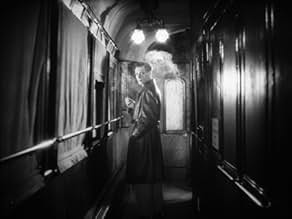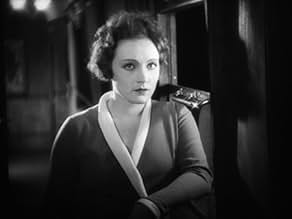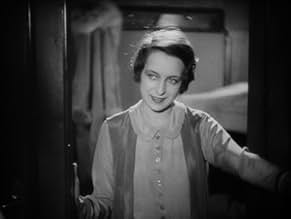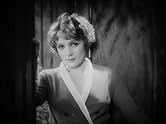Adicionar um enredo no seu idiomaOn his honeymoon with a bride he has wed for business reasons, a man falls for a woman who is in the clutches of a sinister character.After this woman begs him to help her escape, he plots t... Ler tudoOn his honeymoon with a bride he has wed for business reasons, a man falls for a woman who is in the clutches of a sinister character.After this woman begs him to help her escape, he plots to do so using the opportunity of a masked ball.On his honeymoon with a bride he has wed for business reasons, a man falls for a woman who is in the clutches of a sinister character.After this woman begs him to help her escape, he plots to do so using the opportunity of a masked ball.
- Direção
- Roteiristas
- Elenco e equipe completos
- Produção, bilheteria e muito mais no IMDbPro
Enredo
Você sabia?
- Erros de gravaçãoThe train is a clumsy model, and behaves like one, in particular stopping on a dime the moment the communication cord is pulled.
- Versões alternativasThere is an Italian edition of this film on DVD, distributed by DNA srl, "LA CONTESSA ALESSANDRA (L'ultimo treno da Mosca, 1937) + ENIGMA (1929)" (2 Films on a single DVD), re-edited with the contribution of film historian Riccardo Cusin. This version is also available for streaming on some platforms.
- ConexõesFeatured in Marlene Dietrich: Shadow and Light (1996)
- Trilhas sonorasBist du das Glück, nach dem ich mich gesehnt
Written by Giuseppe Becce
Avaliação em destaque
Henri Leblanc ( Herr Uno Henning ), descendant of a bankrupted Industrialist family, marries a rich heiress in order to save the family firm. On the honeymoon, Herr Leblanc meets a mysterious woman on the train, Frau Stascha ( Frau Marlene Dietrich ) with whom he will fall desperately in love. He goes to ruin with her, leaving his wife on the train and fleeing with Frau Stascha to Cannes.
But Stascha, bound to Dr. Karoff ( Herr Fritz Korner ), especially needs the protection of Herr Leblanc due that fact that her relation with the Dr. is connected with the knowledge of a crime.
"Die Frau, Nach Der Man Sich Sehnt" (1929) ( "Three Loves" ), a film directed by Herr Curtis Bernhardt, it is a very remarkable oeuvre and certainly the best silent film made by Frau Marlene Dietrich.
Before this excellent film, Frau Dietrich was a cute and plump fraulein that had a not very impressive career in roles directed by different and sometimes important German directors. That's until Herr Bernhardt takes advantage of all of her true possibilities for the silent screen emphasizing those same traits that later Herr von Sternberg uses in a similar way for the sake and glory of Frau Dietrich.
At this point it is necessary for this German count to say that the work that Herr von Sternberg did with his most outstanding pupil wasn't at all entirely original and exclusive as evidenced in "Die Frau, Nach ", Herr Bernhardt did splendid work in the same artistic and dramatic parameters which, in turn, Herr Dietrich enhanced in the special atmosphere of the silent screen. In years later, it was for Herr von Sternberg to enlarge the talkie career of the Teutonic actress.
The great cinematography by the reputable Herr Curt Courant und Herr Hans Scheib, created those classic sculptured face shots of the actress amid shadows and enigmatic angles creating the paradigm of a "femme fatale". This shines especially in this mysterious love triangle drama. Thus results an "amour fou", perfectly developed in different sceneries with everything for the sake of Frau Dietrich. The film is an unconditional gift and a perfect vehicle for the Teutonic actress that certainly owes a lot to this film's construction in a manner that later became her personal and well-known iconic image.
But not only Frau Dietrich deserves attention in this film; the male main characters of the picture ( Herr Fritz Korner und Herr Uno Henning ) did excellent work too as two tormented lovers whose fascination and infatuation for Frau Stascha will bring them only misery and a doomed life.
The film transits between different sceneries. There are segments of the film that are very well defined and in continuity, developing the increasing passion and dramatism that brings the main characters of the film to life. These start with the industrialist images of the first part of the picture ( in those days, Germans liked a lot scenes of engines, pistons and steam ) which are mechanical, emotionless and symbolic of Herr Leblanc's marriage of convenience. They continue to the uncontrolled passion that Herr Leblanc will experience in the train when he meets Frau Stascha via visualizing an era when the train was a romantic and unpredictable mean of transport... and had nothing in common with the aseptic and fast high-speed trains of nowadays. And at the party at the hotel during the night of the Holy Sylvester, the facts accelerate to the end of this peculiar tragic love triangle via a "in crescendo" film story in which the eroticism, drama and wild passion are depicted in a very remarkable and fascinating way.
"Die Frau, Nach Der Man Sich Sehnt" is an outstanding silent film that depicts one of those mad love stories than only can happen in silent films and confirms that Frau Dietrich already existed and was "invented" by Herr Bernhardt years before Herr von Sternberg.
And now, if you'll allow me, I must temporarily take my leave because this German Count must talk with Frau Dietrich about old German times.
But Stascha, bound to Dr. Karoff ( Herr Fritz Korner ), especially needs the protection of Herr Leblanc due that fact that her relation with the Dr. is connected with the knowledge of a crime.
"Die Frau, Nach Der Man Sich Sehnt" (1929) ( "Three Loves" ), a film directed by Herr Curtis Bernhardt, it is a very remarkable oeuvre and certainly the best silent film made by Frau Marlene Dietrich.
Before this excellent film, Frau Dietrich was a cute and plump fraulein that had a not very impressive career in roles directed by different and sometimes important German directors. That's until Herr Bernhardt takes advantage of all of her true possibilities for the silent screen emphasizing those same traits that later Herr von Sternberg uses in a similar way for the sake and glory of Frau Dietrich.
At this point it is necessary for this German count to say that the work that Herr von Sternberg did with his most outstanding pupil wasn't at all entirely original and exclusive as evidenced in "Die Frau, Nach ", Herr Bernhardt did splendid work in the same artistic and dramatic parameters which, in turn, Herr Dietrich enhanced in the special atmosphere of the silent screen. In years later, it was for Herr von Sternberg to enlarge the talkie career of the Teutonic actress.
The great cinematography by the reputable Herr Curt Courant und Herr Hans Scheib, created those classic sculptured face shots of the actress amid shadows and enigmatic angles creating the paradigm of a "femme fatale". This shines especially in this mysterious love triangle drama. Thus results an "amour fou", perfectly developed in different sceneries with everything for the sake of Frau Dietrich. The film is an unconditional gift and a perfect vehicle for the Teutonic actress that certainly owes a lot to this film's construction in a manner that later became her personal and well-known iconic image.
But not only Frau Dietrich deserves attention in this film; the male main characters of the picture ( Herr Fritz Korner und Herr Uno Henning ) did excellent work too as two tormented lovers whose fascination and infatuation for Frau Stascha will bring them only misery and a doomed life.
The film transits between different sceneries. There are segments of the film that are very well defined and in continuity, developing the increasing passion and dramatism that brings the main characters of the film to life. These start with the industrialist images of the first part of the picture ( in those days, Germans liked a lot scenes of engines, pistons and steam ) which are mechanical, emotionless and symbolic of Herr Leblanc's marriage of convenience. They continue to the uncontrolled passion that Herr Leblanc will experience in the train when he meets Frau Stascha via visualizing an era when the train was a romantic and unpredictable mean of transport... and had nothing in common with the aseptic and fast high-speed trains of nowadays. And at the party at the hotel during the night of the Holy Sylvester, the facts accelerate to the end of this peculiar tragic love triangle via a "in crescendo" film story in which the eroticism, drama and wild passion are depicted in a very remarkable and fascinating way.
"Die Frau, Nach Der Man Sich Sehnt" is an outstanding silent film that depicts one of those mad love stories than only can happen in silent films and confirms that Frau Dietrich already existed and was "invented" by Herr Bernhardt years before Herr von Sternberg.
And now, if you'll allow me, I must temporarily take my leave because this German Count must talk with Frau Dietrich about old German times.
- FerdinandVonGalitzien
- 23 de dez. de 2010
- Link permanente
Principais escolhas
Faça login para avaliar e ver a lista de recomendações personalizadas
Detalhes
- Tempo de duração1 hora 16 minutos
- Cor
- Mixagem de som
- Proporção
- 1.33 : 1
Contribua para esta página
Sugerir uma alteração ou adicionar conteúdo ausente

Principal brecha
By what name was Die Frau, nach der man sich sehnt (1929) officially released in India in English?
Responda























